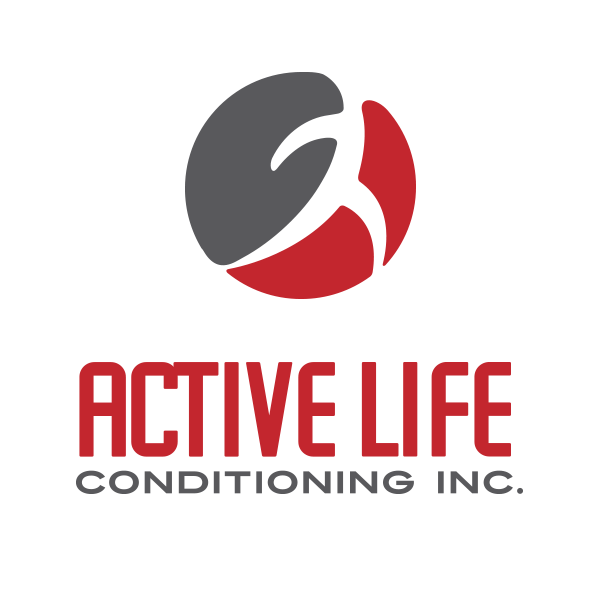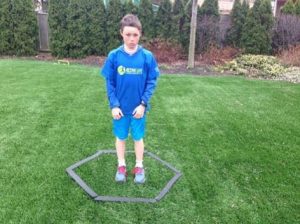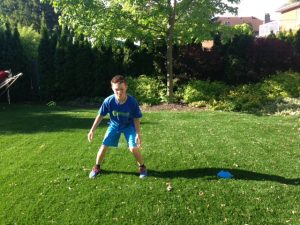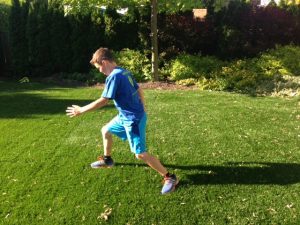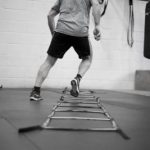Using Athletics and Strength and Conditioning Programs to keep kids Active for Life
Using Athletics and Strength and Conditioning Programs to keep kids Active for Life
(Sarah Applegarth M.Sc, CSCS, CSEP-CEP, R.Kin)
With the lack of daily public school based gym curriculum and the allure of screen time, the incidence of obesity in Canada has our country receiving an F on the physical activity report card . In 1978, 14% of Canadians were considered obese. This obesity number has risen in 2015 to 25% in adults and 24.5% of 15year olds reported as overweight. This number is projected to rise to 30% by the year 2030 (1). The impact of this will resonate for many years to come with a heavy impact on our healthcare system and the sedentary culture of the generations to come.
Participation in sport and supplementary strength and conditioning programmes are necessary to provide kids with a platform to learn how to move their bodies in creative and coordinated ways while developing the physical literacy required to maintain an active life into adulthood. Through sport we are running in to a unique issue of specializing kids into late specialization sports at an early age to try to achieve elite status. Hockey is a great example of this as we have 8 and 9 year olds playing 70+ hockey games through the winter and continuing to fill their spring and summers with hockey tournaments. This is setting kids up to miss the windows of opportunity to develop and optimize other crucial skills like running, jumping, throwing and swimming through participation in typical summer activities like soccer and baseball. Prior to the age of 12, the physical literacy skills can be optimized if they are introduced through sport participation and in unstructured and/or structured play. Physical literacy skills consist of gross motor skills like running, jumping, kicking, throwing and the ABC’s of movement (agility, balance, coordination and speed) and KGB’s of athleticism ( kinesthetic sense, gliding, buoyancy, sliding)(2).
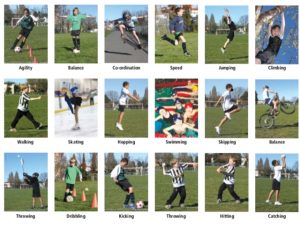
Figure 1. Fundamental Movement Skills and Fundamental Sports Skills (2).
In 2015, the International Olympic Committee made its boldest statement yet on youth athletic development noting “Empirical evidence shows that a diversity of activities in early development is an indicator of continued involvement in more intense activities later in life, elite performance and continued participation in sport”(3).
Our Canadian Sport for Life long term athlete development model has broken down the physical requirements of athletic development into the 5S’s : Suppleness, Speed, Skills, Strength and Stamina. There is well documented evidence that there are windows of trainability in childhood where these physical skills can be optimized to reach genetic potential if introduced at the right time. Figure 2 summarizes these windows of sensitivity. All research done on speed and flexibility is based on chronological age. The solid lines represent that research. The dotted lines represent the sensitive periods of accelerated adaptation to training based on developmental age. The dotted lines are defined by the onset of the growth spurt. The fastest rate of growth or Peak Height Velocity (PHV) occurs after growth decelerates. From Figure 2 you can see that the sensitive period for Stamina occurs at the PHV. Aerobic capacity training is recommended before athletes reach PHV. Aerobic power should be introduced progressively after PHV when growth rate decelerates. The sensitive period for Strength in girls is immediately after PHV or at the onset of menarche, while for boys it is 12 to 18 months after PHV. For boys, the first sensitive period for Speed occurs between the ages of 7 and 9 years, and the second occurs between the ages of 13 and 16. For girls, the first sensitive period for Speed occurs between the ages of 6 and 8 years, and the second occurs between the ages of 11 and 13. 4. The sensitive period for optimal Skill training generally takes place between the ages of 9 and 12 years for boys and between the ages of 8 and 11 for girls, or more precisely before the onset of adolescent growth spurt (the “skill hungry” years). The sensitive period for suppleness (flexibility) for both genders occurs between the ages of 6 and 10. Although flexibility training during puberty yields good results, special attention should be paid to flexibility during the adolescent growth spurt, due to stresses on muscles, ligaments and tendons by the rapidly growing bones(2).

Figure 2. Peak Height Velocity Graph with the 5S of Training and Performance Sensitive Periods. (4)
Being involved in activities like gymnastics, tennis and track and field are great for exposure prior to the PHV as they encompass all the basic movement skills and the ABC’s of athleticism. Similarly, participating or competing in cardiovascular activities like swimming, soccer rugby, cross country running and mountain biking at PHV will allow for aerobic system training during the window of opportunity to reach genetic potential in that system. Post PHV athletes need to consider starting to build on their strength capabilities as power as there is a window of trainability 12-18 months post growth spurt where this is very sensitive to training.
As strength and conditioning coaches this is crucial information to keep in mind when designing team and youth programmes. Understanding what stage your athlete(s) is in can be done by plotting their physical growth on a monthly basis to determine when a rapid change has occurred and they are in their PHV. Alternatively the University of Saskatchewan has a great on line resource (5) where you can plug in simple anthropometric variables and get a print out of when an athlete is going to reach PHV and what their adult stature will be. As the training age advances, a coach needs to prepare proper exercise progressions and regressions to adjust for the differing needs of athletes within the same training group or team. This information can be utilized to design an educated plan for your growing athletes and educate parents on the types of supplementary activities they can get involved with to assist in becoming a well-rounded athlete and maximizing their potential.
Regardless of the sensitive periods, all fitness attributes need to be trained at all ages. They will not be optimized outside of the windows of trainability but they can still be improved. When designing a programme for any developing athlete is it important to know both their physiological stage and their current fitness and skill level. A small battery of field tests can give you a sense of where your athlete is and help to direct your exercise selection and priorities.
| Variable | Sample Tests | Pre PHV norms | Post PHV norms |
| Movement Screens | Y Squat Inline lunge |
2.5-3/3 2.5-3/3 |
2.5-3/3 2.5-3/3 |
| Agility/ Speed | Pro Agility Test, Hex Rail –slats 3xcw & ccw 40yd sprint (for technique and time) |
5.5+/-.5s
34+/-2s 5.97s |
5.02+/-.24s
31+/-2s 5.97s |
| Leg Strength/Power | Standing long jump, Pente Jump, Vertical Jump |
150cm not found 26cm |
200.5cm not found 52cm |
| Cardiovascular | Aerobic- Australian Institute Shuttle Anaerobic -60sec lateral Box Jumps |
Level 7.05+
30cm ht- 55+ |
Level 10.05+
40cm ht- 60+ |
Table 1. Samples of Fitness Testing for Pre and Post PHV Males (6,7,8)
Pre PHV youth programming should be circuit like in nature and teach technique of basic strength movements like squats, lunges, push ups, pull ups and introducing power movements like kettlebell swings, DB snatch, Olympic bar hang cleans and various DB strength movements. Once taught and mastered, speed and coordination drills like Hex Rail (Figure 3. & video), cone shuffle (Figure 4.& video) and Dot drill (Figure 5. & video), color cone drill (Figure 6.& video) along with balance work should be incorporated into these circuits. General cardiovascular fitness will also be enhanced through the continuous circuit. If a variable tested poorly then incorporate extra
Post PHV programming should build off the exercises that have been mastered in the earlier phases of training. Supersets and trisets can be incorporated. Table 2. Shows a sample program of this.
| DWU 0-15’ | Dynamic Warm ups | |||
| MP 15-20′ | Hip ROM, Scap stability-red band pro/retractions in hinge, Roller Deadbugs | |||
| SAQ 15-25′ | Pro Agility Races- forward and lateral 3x/ direction.Rest | |||
| Core 25-35′ | Pallof press | 3 | 10/s | |
| Rev. Diver Hold (low back) | 20 sec | |||
| Bear Crawl | 2 widths | |||
| Strength 35-60′ | Exercise | Sets | Reps | Tempo/Rest |
| Hang Cleans | 5 | 5 | 2 min | |
| Bulgarian Split Squats | 3 | 8/s | 211/A1 | |
| Overhead Press | 8/s | 211/A2 | ||
| Bench Hip Hinges | 3 | 12 | 232/B1 | |
| Pull ups | 8 | 212/B2 | ||
| Finisher 60-70′ | 2-4-6-8-10 | |||
| Push ups and Goblet Squats | ||||
| Mobility 70-75′ | Hips and T-spine | |||
Table 2. Sample Active Life Performance Workout for Post PHV Athletes
Figure 3. Hex Rail Agility Exercise (click photo for video)
Figure 4. Lateral Cone Shuffles (click photo for video)
Figure 5. Dot Drill (click photo for video)
Figure 6. MultiColored Cone (click for video)
Systematically through an organized, thoughtful approach to child sport activity participation and complimentary training programmes, we can ensure children hit the window of opportunity for physical literacy and 5S of sport performance to help reach their genetic potential. This will have them more apt to participate in physical activities through to adulthood and beyond. The impact of this will resonate with a healthier mental, emotional and physical society.
References:
- http://www.oecd.org/els/health-systems/Obesity-Update-2017.pdf
- http://sportforlife.ca
- https://www.admkids.com/page/show/1205402-physical-literacy
- Balyi, I .Way, R, Higgins, C. Norris, S. & Cardinal, C. 2005. Canadian Sport For Life: Long Term Athlete Development (Resource Paper). Vancouver, Canada: Canadian Sport Centres.
- https://www.usask.ca/kin-growthutility/
- Hoffman, J. Norms for fitness, performance and health. Chicago: Human Kinetics, 2006.
- Applegarth, S. Alpine Ontario Fitness Testing Normative Data 1999-2019.
- https://www.functionalmovement.com/articles/740/what_i_look_for_in_an_fms_score
Sarah is the owner and an exercise physiologist at Active Life Conditioning, a 5000sq ft multidisciplinary training centre in Collingwood Ontario. She has been working with youth and elite athletes for over 20 years and works with Provincial sport bodies in Alpine skiing, Snowboarding and is the lead strength and conditioning coach for the Grey Bruce Highlanders AAA hockey organization. Her clients include various professional and semi pro hockey players, and other aspiring developmental, provincial and varsity calibre athletes. Check out Active Life Conditioning at www.activelifeconditioning.com or http://www.facebook.com/Activelifeconditioning/
contact [email protected]
